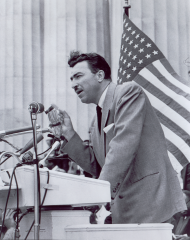Keeping the Faith: African Americans Return to Congress, 1929–1970
With his election to the U.S. House of Representatives from a Chicago district in 1928, Oscar De Priest of Illinois became the first African American to serve in Congress since George White of North Carolina left office in 1901 and the first elected from a northern state. But while De Priest’s victory symbolized renewed hope for African Americans struggling to regain a foothold in national politics, it was only the beginning of an arduous journey. The election of just a dozen more African Americans to Congress over the next 30 years was stark evidence of modern America’s pervasive segregation practices.
 /tiles/non-collection/b/baic_cont_3_powell_adam_capitol_steps_lc_usz62_126515.xml
Image courtesy of Library of Congress
Adam Clayton Powell, Jr., of New York, a charismatic and determined civil rights proponent in the U.S. House, served as a symbol of black political activism for millions of African Americans.
/tiles/non-collection/b/baic_cont_3_powell_adam_capitol_steps_lc_usz62_126515.xml
Image courtesy of Library of Congress
Adam Clayton Powell, Jr., of New York, a charismatic and determined civil rights proponent in the U.S. House, served as a symbol of black political activism for millions of African Americans.
Demographic shifts continued to transform the black political base during these decades, fundamentally recasting the background and experiences of black Members of Congress. None of the black Members from this period represented a southern district or state—a testament to the near-complete disfranchisement of southern blacks and a massive, decades-long migration of millions of African Americans employed in agricultural work in the South to urban areas in the North in search of industrial jobs. While their representation of northern cities alone would have distinguished this group of black Members from their Reconstruction-Era predecessors, they were also overwhelmingly Democratic, sharply contrasting with the uniformly Republican 19th-century African Americans in Congress. New Deal reforms providing a modicum of economic relief—and, more compellingly, the promise of fuller participation in American life—drew Black Americans away from the party of Lincoln and into a durable Democratic coalition built by President Franklin D. Roosevelt. With the exception of De Priest and Senator Edward Brooke of Massachusetts, all the black Members of Congress from this era were Democrats.
 /tiles/non-collection/b/baic_cont_3_drinking_fountain_-April_1938_courthouse_lc_dig_fsa_8a03228.xml
Image courtesy of Library of Congress
Jim Crow reigned in North Carolina in the 1950s, where water fountains on the Halifax County courthouse lawn bore the signs of segregation.
/tiles/non-collection/b/baic_cont_3_drinking_fountain_-April_1938_courthouse_lc_dig_fsa_8a03228.xml
Image courtesy of Library of Congress
Jim Crow reigned in North Carolina in the 1950s, where water fountains on the Halifax County courthouse lawn bore the signs of segregation.
Like their Reconstruction-Era predecessors, these African-American Members endured racist slurs and prejudicial slights that complicated their development as legislators. Too few to effect change as a voting bloc within Congress, they acted either as public advocates commanding the spotlight on behalf of racial equality or as patient insiders who sought to deliver economic and political benefits to black constituents by accruing influence within the existing power structure. Yet the symbolism of this handful of black congressional careers initiated between the onset of the Great Depression and the social ferment of the late 1960s far exceeded the sum of its parts. Arguably for the first time, Black Americans who sent Members to Capitol Hill were substantively rewarded with legislative efforts made expressly on their behalf. “Keep the faith, baby,” Representative Powell famously intoned, “spread it gently and walk together, children.”1 His oft-repeated words captured the essence of African Americans’ growing collective political activism.
Footnotes
1Thomas A. Johnson, “A Man of Many Roles,” 5 April 1972, New York Times: 1.








